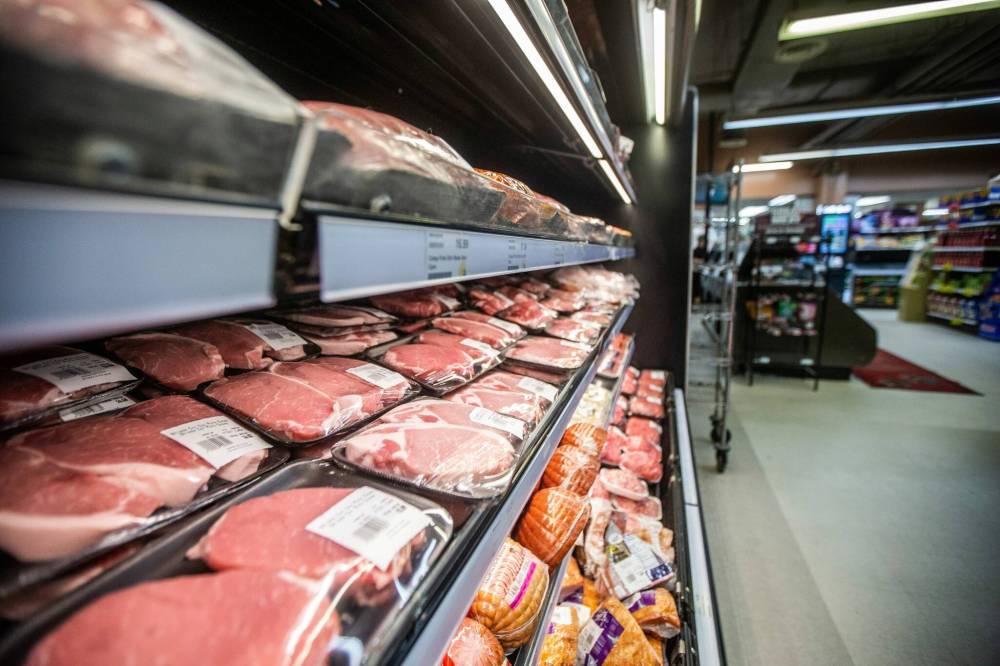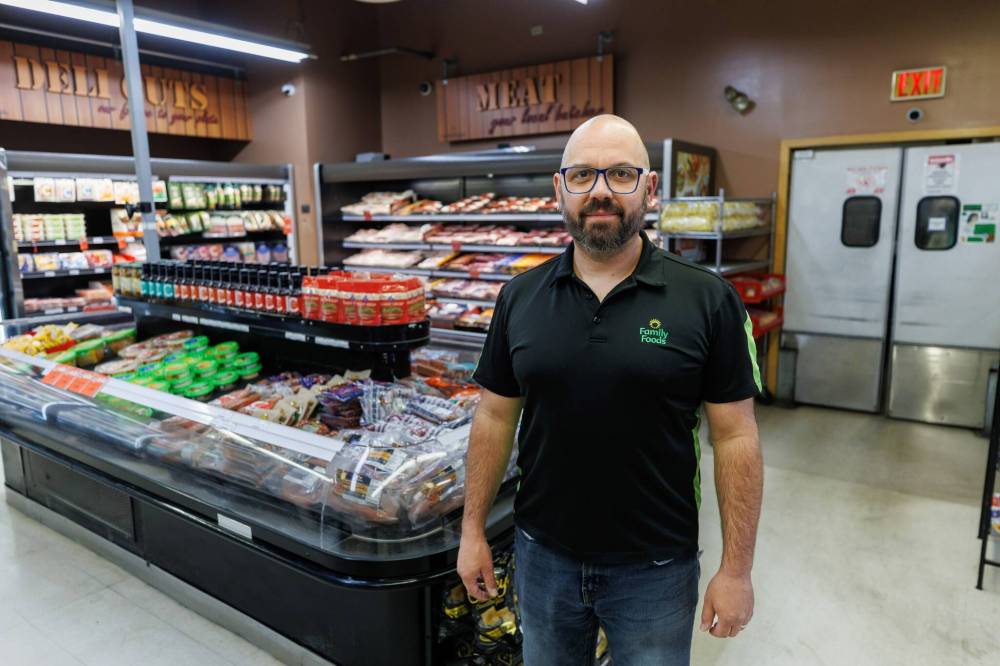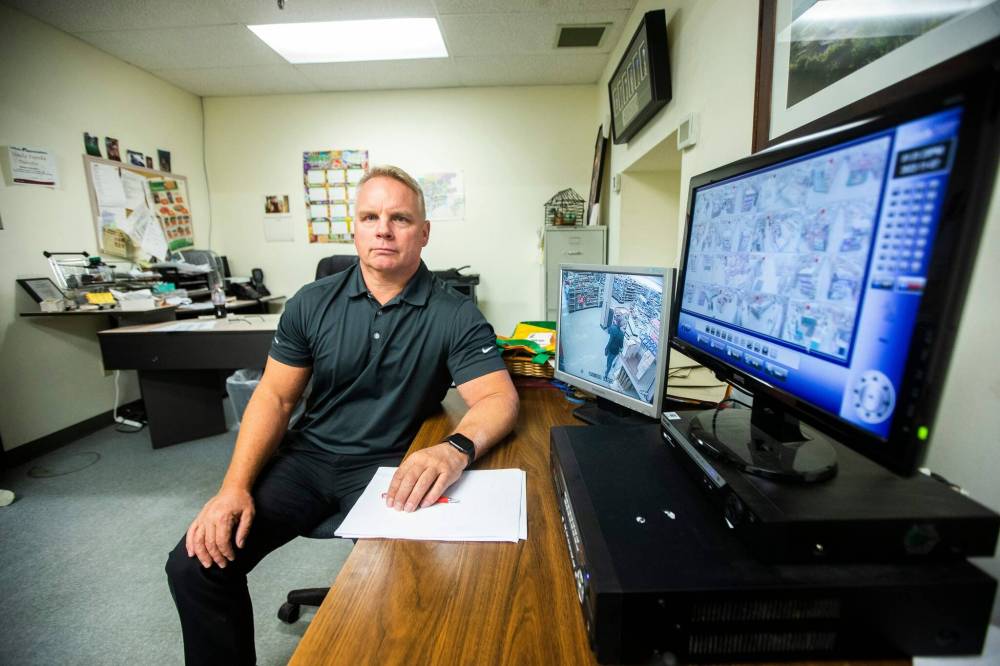This is the first of a two-part series on shoplifting. Today, reporter Mike McIntyre takes a detailed look at the growing problem in our city and what is behind it.
As the employee looks out the front window of the Winnipeg grocery store just before 7 a.m., plenty of eager customers are lined up waiting for the doors to open.
Most of them are familiar faces: seniors who want the first crack at the freshly baked goods or parents who forgot to pick up items for their child’s lunch. But the crowd includes another group of people — habitual thieves who are, once again, about to barge in and steal whatever they want.
“It’s gotten right out of hand. It’s just nuts,” the exasperated employee says.
“There’s a group of people that are there every day. It’s very well-organized. You can’t touch them, and they know you can’t touch them. We have regulars — we know them by their first name. They come in and they say ‘(Expletive) you, get the (expletive) out of my way.’”
It’s the Wild West in the world of retail, a dangerous place where lawlessness rules and the criminal element is getting its way in what experts say is a $200 million-a-year industry in Manitoba — and is exploding at an alarming rate.
“We have this one guy… He’ll load up a cart and walk right out, and we can’t do a thing about it. It’s demoralizing.”–Store employee
Theft is no longer a “victimless crime” committed by bored teenagers or desperate perpetrators simply trying to survive.
Now, there’s now a level of sophistication and organization. At times, there’s gratuitous violence. Hammers, screwdrivers, syringes, machetes and guns are the tools of the thieves’ trade.
You name it, they often have it. And they’re ready to use the weapons against anyone who tries to stop them.
“We have this one guy, a big guy, he’ll go right to the steaks… ribeyes, T-bones, you name it. He’ll load up a cart and walk right out, and we can’t do a thing about it,” the worker says. “It’s demoralizing.”
His store has loss-prevention officers, but they may as well be mannequins, given the “hands-off” policy they are under. At best, their presence might cause someone to think twice about stealing. A suspicious glare is often the only security tool at their disposal.
The grocery chain has brought in off-duty Winnipeg police officers, who are in full uniform, during peak hours. While it costs thousands of dollars a day, they often play the role of a scarecrow.

MIKAELA MACKENZIE / FREE PRESS FILES
Big stores now routinely allow shoplifters to walk away scot-free as long as the total value of the goods they take isn’t more than $1,000.
“I guess the premise of us being there is a deterrent. You almost feel like a Walmart greeter,” says a longtime member of the police service who routinely takes shifts at a Superstore outlet.
“When we first started around 2018, we were getting, easily, five or six arrests in a night. A bit of the negative side to that is that would tie up police resources on the streets, which means less police to go to you if you need help. Then Superstore was like ‘holy (expletive), we’ve got to pay all these officers to go to court on these.’”
That led to a significant change: big stores routinely allow shoplifters to walk away scot-free as long as the total value of the goods they take isn’t more than $1,000. Anything less is not worth the resources — particularly overtime needed to process arrests, along with potential court time down the road — and written off as “shrinkage.”
There are exceptions, such as when a person is wanted on outstanding warrants.
However, the prospect of a free pass, which has become common knowledge among criminals, has added fuel to the fire.
“Every day, stealing every day,” the chain grocery-store worker says. “They’re doing it for one reason and one reason only: there are no consequences.”
Big chains — Safeway, Superstore and Sobeys — are taking a beating, which is one they are built to withstand to a certain degree. But mom-and-pop shops are ill-prepared to handle the spike in crime and the danger that comes with it.

MIKE DEAL / FREE PRESS
“People you thought would never steal, you’re catching them putting things in their pocket,” says Kevin Schmidt, owner of Downtown Family Foods at 120 Donald St.
“Being independent, being reliant on what you sell… (crime) affects your bottom line. I put myself in the way of people that try to do that because I look at it as what are they stealing and how much am I losing?” says Kevin Schmidt, owner of Downtown Family Foods at 120 Donald St.
He can’t afford to bring in outside help, nor is allowing someone to get away with crime a good business decision, but he quite literally has to take matters into his own hands at times.
“It doesn’t help that things are getting more and more expensive now. People you thought would never steal, you’re catching them putting things in their pocket,” says Schmidt. “I will confront them and try to stop them. We don’t want them to think they can walk in at any time and walk out without being noticed.”
But that’s dangerous.
Case in point, the spate of violence that has become personal and increasingly volatile at the family owned Food Fare location at Portage Avenue and Burnell Street. Several people have attacked staff, and two set fire to vehicles belonging to co-owner Tarik Zeid and his cousin on May 24.
The incidents followed a high-profile incident last month in which an employee punched a woman who had shoplifted when they fought over her bag.
“I don’t want that product just walking out of here, because we worked really hard to be able to bring it in and put it in place for someone to purchase,” Schmidt says about putting himself in harm’s way, something he tells his employees not to do.
“After, when I think about it, it’s like, ‘Oh, man, that could have turned worse.’”
Scott Clement of Dakota Family Foods faces the same dilemma; the escalation in crime is impossible to ignore.
“Before, it was kind of a weekly incident. Now it’s daily. Sometimes, it feels almost hourly,” he says.
“The origin of the problem, why it’s getting so bad now, is because of the leniency that stores are having. Word, unfortunately, gets out. Thieves realize once they get caught, there are no consequences, and so it jumps up to the next level. They continue it more and more and more.”
A few weeks ago, a thief pulled a knife on one of Clement’s employees as he fled the store. There was also a recent bear-spray attack. That’s led to a constant fear about what could happen next, in addition to the hit on the bottom line.
“We’re a small business and it comes right out of our pockets,” Clement says. “To a certain extent it gets passed on to the customers. I think everyone knows that.… If people are coming in and helping themselves, unfortunately it has to be passed on somewhere down the road or we’re not going to be in business.”

MIKAELA MACKENZIE / FREE PRESS FILES
“Thieves realize once they get caught, there are no consequences, and so it jumps up to the next level,” said Scott Clement, owner of Dakota Family Foods.
The Retail Council of Canada describes Winnipeg as “the hub” of a growing $5 billion annual problem across the country, one that is rapidly evolving in a post-pandemic world.
“This is now very professional,” says Rui Rodrigues, the council’s loss prevention and risk manager.
“There’s still an element of shoplifting that is your typical first-time offender, whether it’s young people, bored housewives, you name it. They see an opportunity and take it. But the change we’ve seen is the increase in violence with prolific offenders, and the increase in retail crime.”
Rodrigues says the explosion of online shopping is a major driver because shoplifters know they can sell the hot goods in a hurry under relative anonymity.
Those on the front lines in Winnipeg see it, too.
For example, the city police officer who puts in extra shifts at Superstore, once caught a “mountain of a man” trying to walk out with $4,800 in meat products. He had a machete hidden beneath his pants.
“There were literally packages falling out of his cart, it was so full,” he says.
“I could pretty much give him a shopping list and he’d go get it for me.”–Police officer
While processing the arrest, the officer asked the thief what he’d planned to do with his haul. He mentioned he would have sold it at various locations, including downtown bars and hotels where he’d typically sell it at 80 per cent off the sticker price.
“He told me this is what he does for a living,” he says.
A family affair, it turns out. The next day, his partner caught the man’s mother stealing from the same store.
On a personal level, the officer recently went to buy a charger for his cordless drill through Facebook Marketplace. He arrived at the seller’s home and realized he’d stumbled across a fencing operation — people who knowingly buy and resell stolen goods — because the man asked him what else he might be interested in buying.
“He says, ‘What do you need? Just go to Home Depot, take a picture of it for me and I’ll get it for you,’” the officer explains. “I could pretty much give him a shopping list and he’d go get it for me.”
Rodrigues describes the scenario as “steal-to-order,” which he says is the biggest change in recent years. The soaring cost of living has prompted consumers to look harder for deals, even if it means getting thieves to do their “shopping.’
Shoplifting rate tripled
Meat is a popular commodity, but the list is long: cheese, laundry detergent, medicine, baby formula, diapers, tools, electronics. Anything with value that can be sold quickly on the black market, whether in person or online.
“We have a lot of fences across the country, people in a place like Winnipeg who will go to marginalized individuals on the streets who may be dealing with mental health, drug addictions, alcoholism, and they’ll say, ‘Look, if you steal this for me, I’ll give you a few bucks.’ And they’ll do it,” Rodrigues says.
Even thieves who do get caught typically receive little more than a slap on the wrist when they go to court.
“These folks continue to get more brazen through that. We’ve seen a 300 per cent increase in crimes that carry violence compared to 2019,” says Rodrigues.
Since 2020, the rate of overall shoplifting has typically tripled year over year.
“Where we might have heard of a robbery once in a blue moon in retail, now it’s a daily occurrence. So that’s been our focus. It’s not the individual shoplifter, it’s really from a community-safety perspective. It’s become a big concern for employees and customers.”

Defence lawyer Chris Sigurdson says there’s a subculture that’s been built up related to moving and fencing stolen goods.
Veteran defence lawyer Chris Sigurdson, who has taken on hundreds of shoplifting cases during his career, said a troubling shift has been unfolding.
“The pockets of violence are worse. It used to be, maybe, a tussle. Now you have weapons, you have knives, needles. The level of violence seems to have increased,” he says.
“I think that may be, in part, because of the desperation and, in part, because they feel the need to do that, which is very unfortunate. Shoplifting is, obviously, a problem for society. It raises prices, it causes problems. But the societal problem of the violence and the fear that gets put into people just trying to do their jobs is difficult.”
Sigurdson cites a recent case in which a woman, who was a habitual shoplifter at a Dollarama store, was making her way out of the front door with a cart full of stolen items. The owner tried to stop her. She retreated to the kitchen aisle, grabbed two knives, tore open the packaging and was suddenly armed.
“It was like, enough’s enough. That’s when the problems happen. Thankfully, no one was hurt in that exchange, but the potential is there,” he says.
He had another case in which a thief, who was as “high as a kite,” was armed with a handgun. He pointed it at the clerk and pulled the trigger. Thankfully, it misfired.
Sigurdson says there’s a subculture that’s been built up related to moving and fencing stolen goods. People who had been drug dealers have taken up the crime.
“If you know there is a ready and quick market and what you have can be turned over, then, obviously, that changes the equation,” he says. “People realized you can get in a lot more trouble being a drug dealer than fencing stolen goods. I’ve hardly ever seen a case of any of these middlemen even being arrested.”
The grocery chain worker worries the worst is still to come.
“Everybody’s frustrated. Manitoba Justice is frustrated and they partner with us. Retail, police, all levels of government, consumers, everybody’s frustrated.”–Insp. Jennifer McKinnon
“This girl was walking out with a full shopping cart and (a customer) saw that we couldn’t do anything. This guy was fed up, grabbed the cart away from her and said, ‘I’m sick and tired of paying for your (expletive) groceries,’” he says.
“That was a customer. I can’t do that. So, the customers are either intimidated or they’re starting to get — I don’t want to use the word vigilantes, because that’s a little bit harsh — but they’re starting to retaliate a little bit.”
To be clear, outlaw motorcycle and street gangs aren’t believed to be involved, but the structure emerging in these new criminal groups is eerily similar.
“This surge in organized retail crime remains a significant problem for the retail industry,” Loblaw chief financial officer Richard Dufresne said during a conference call last year.
“These are sophisticated organizations that are increasingly using violent tactics and complex networks to steal and sell stolen goods for profit.”
All of which has the Winnipeg Police Service on guard, especially given the uptick in violence.
“I think even the big stores, it’s beyond the dollar amount now. This comes down to people’s safety, to people being able to go out, work jobs, support their own families and be safe doing that,” says Insp. Jennifer McKinnon of the major crimes unit.
“And then the safety of… consumers. Everybody’s frustrated. Manitoba Justice is frustrated and they partner with us. Retail, police, all levels of government, consumers, everybody’s frustrated.”
mike.mcintyre@freepress.mb.ca
X: @mikemcintyrewpg
On Tuesday, we’ll explore some of the solutions being proposed and implemented by stakeholders.

Mike McIntyre
Sports reporter
Mike McIntyre is a sports reporter whose primary role is covering the Winnipeg Jets. After graduating from the Creative Communications program at Red River College in 1995, he spent two years gaining experience at the Winnipeg Sun before joining the Free Press in 1997, where he served on the crime and justice beat until 2016. Read more about Mike.
Every piece of reporting Mike produces is reviewed by an editing team before it is posted online or published in print — part of the Free Press‘s tradition, since 1872, of producing reliable independent journalism. Read more about Free Press’s history and mandate, and learn how our newsroom operates.
Our newsroom depends on a growing audience of readers to power our journalism. If you are not a paid reader, please consider becoming a subscriber.
Our newsroom depends on its audience of readers to power our journalism. Thank you for your support.